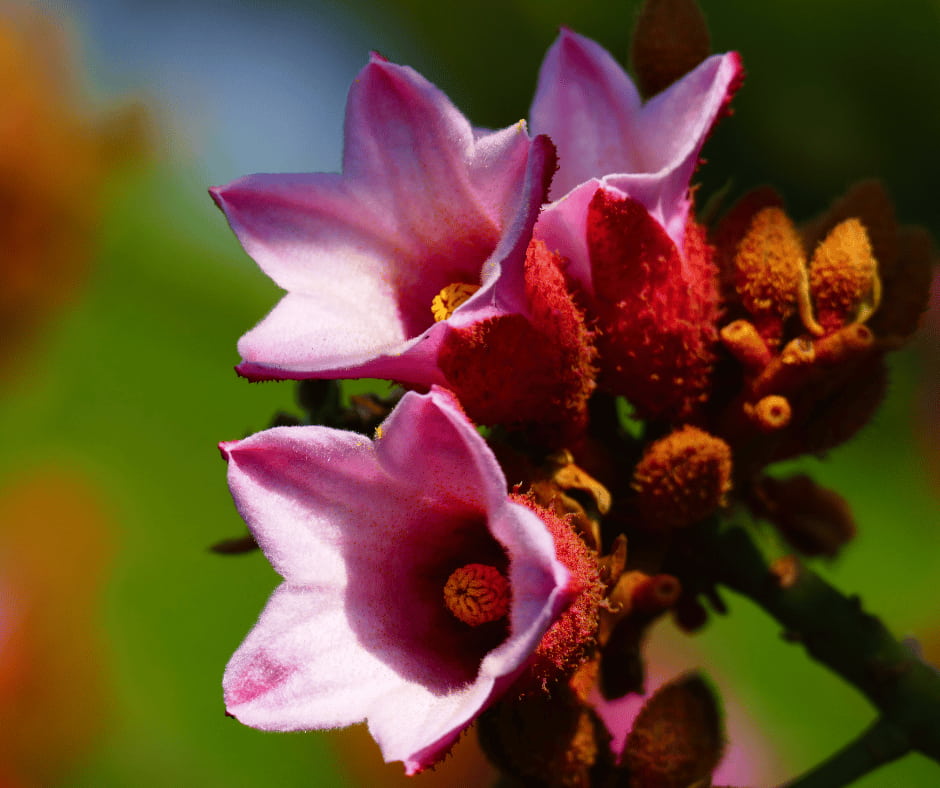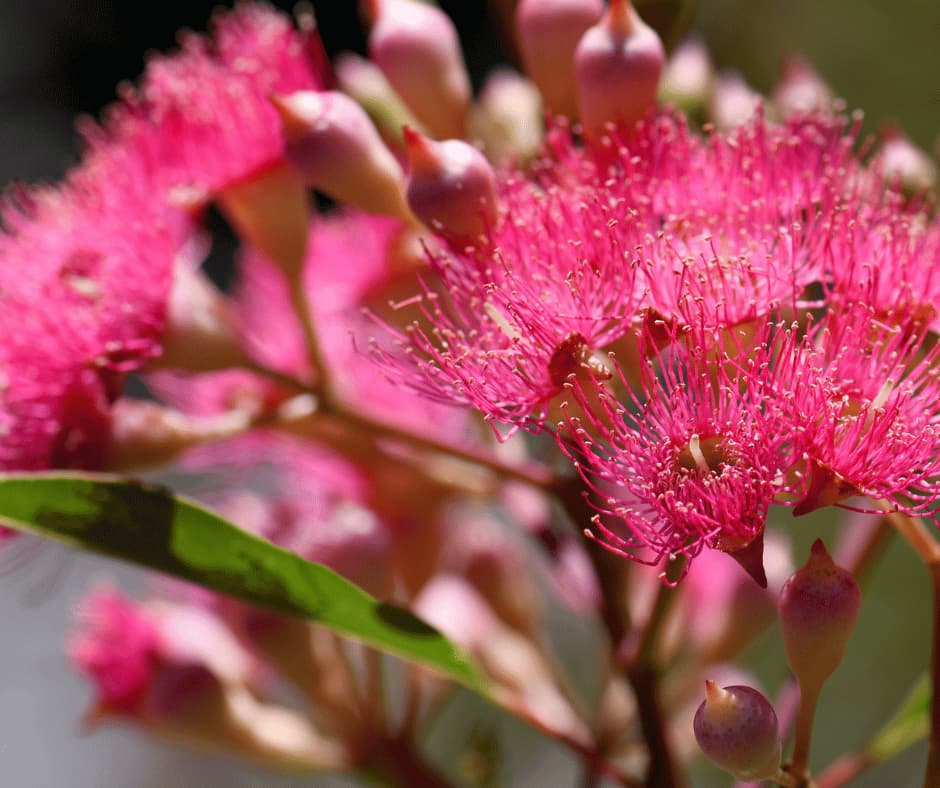In Australia, we’re blessed with a stunning array of pink flowering trees, each adding vibrant colour to our diverse landscapes. From the delicate blossoms of the Silver Princess to the bold hues of the towering Pink Trumpet Tree, these trees are more than just a pretty sight. They bring ecological benefits, enhance garden aesthetics, and offer a sense of connection to the natural world.
This article will explore eight remarkable pink flowering trees that grace Australian gardens. We’ll delve into their unique characteristics, benefits to your garden, and essential care tips to keep them thriving!
Before we dive in if you want to continue researching different tree colours in Australia, check our guides on blue, yellow, white, red, or purple flowering booms!
Pink flowering tree identification
Identifying pink flowering trees in Australia is a delightful journey through nature’s artistry. Each tree has unique features that make it stand out. When trying to identify these beauties, pay close attention to several key characteristics:
- Leaf shape and texture: The leaves can vary widely among species. Some, like the Silver Princess, have long, slender, eucalyptus-like leaves, while others, such as the Lacebark Tree, boast broader, heart-shaped foliage. The texture, whether glossy, leathery, or soft, also provides clues to the tree’s identity.
- Bark texture: Bark is often overlooked but is a crucial identification feature. The Pink Flowering Gum, for example, has a smooth, often multi-coloured bark. At the same time, the Kurrajong may exhibit a more fibrous texture.
- Flower characteristics: This is where these trees truly shine. Observe the size, shape, and arrangement of the blossoms. The Queensland Tree Waratah features large, brush-like flowers, whereas the Thyme Honey-myrtle displays smaller, delicate blooms. Note the shades of pink, from soft, almost white pinks to deep, vibrant hues.
- Growth habit and size: The overall shape and size of the tree can be a giveaway. Some species, like the Pink Flowering Yellow Gum, grow tall and imposing. In contrast, others, such as the Summer Beauty, are more compact and suitable for smaller gardens.
By familiarising yourself with these aspects, you’ll be well-equipped to identify the stunning variety of pink flowering trees Australia offers.
Benefits of pink flowering trees in gardens
Pink flowering trees are not just a feast for the eyes; they offer many benefits that extend far beyond their aesthetic appeal. Here’s why incorporating these trees into your garden is a wise and rewarding choice:
- Aesthetic appeal: Pink flowering trees, with their vibrant blossoms, instantly elevate the beauty of any garden. They create stunning focal points, add a splash of colour, and can transform a mundane landscape into a picturesque haven. The diverse range of pinks, from soft pastels to vivid hues, ensures a tree complements every garden style.
- Environmental impact: These trees play a crucial role in the environment. They contribute to air purification by absorbing pollutants and exhaling clean oxygen. Their foliage provides shade, which helps in reducing soil temperature and moisture loss, making your garden more energy-efficient.
- Ecological benefits: Pink flowering trees are a magnet for wildlife. They attract pollinators, including bees, butterflies, and birds, thus promoting biodiversity. This is particularly vital in urban areas where green spaces are limited. By planting these trees, you’re creating a mini-ecosystem and contributing to the health of your local environment.
- Seasonal interest: Many pink flowering trees have the added advantage of offering seasonal interest. They may feature vibrant autumn foliage or interesting bark patterns in winter, ensuring your garden remains attractive.
Incorporating pink flowering trees into your garden is not just about adding beauty; it’s about positively impacting the environment and contributing to the well-being of both humans and wildlife.
Best Australian trees with pink flowers
Australia’s gardens are graced with an array of pink flowering trees, each with unique charm and beauty. Among the best, here are our favourite trees with pink flowers:
- Silver Princess (Eucalyptus caesia)
- Thyme Honey-myrtle (Melaleuca thymifolia)
- Lacebark Tree (Brachychiton discolor)
- Summer Beauty (Corymbia ficifolia)
- Pink Flowering Gum (Corymbia ficifolia)
- Kurrajong (Brachychiton populneus)
- Pink Flowering Yellow Gum (Eucalyptus leucoxylon ‘Rosea’)
- Pink Trumpet Tree (Tabebuia impetiginosa)
These trees enhance the visual appeal of our landscapes and contribute significantly to the ecological balance. Let’s delve deeper into these species to understand their unique characteristics and why they are essential in any Australian garden.
Small trees with pink flowers
1. Silver Princess (Eucalyptus caesia)

The Silver Princess, a jewel in Australian horticulture, is a small, captivating tree with its unique features. Here’s an expanded view of its characteristics and ideal garden settings:
- Botanical characteristics: This tree is celebrated for its elegant weeping habit and striking, peeling bark that reveals a glossy, red-brown underlayer. Its blue-grey leaves beautifully contrast with the large, bell-shaped pink flowers that bloom in late winter to spring, attracting various nectar-loving birds and adding a vibrant splash of colour to the garden.
- Ideal growing conditions: Best grown in well-drained, sandy loam soils, the Silver Princess flourishes in full sun but can tolerate partial shade. Once established, it shows remarkable drought tolerance, making it a resilient choice for gardens in arid climates or water-wise landscaping.
- Growing height: With a typical height ranging from 5 to 8 metres, it’s perfectly sized for smaller gardens needing a standout feature or an elegant addition to larger landscapes. Its manageable size also makes it ideal for residential gardens where space is premium.
- Common uses: The Silver Princess is often a focal point in garden designs due to its unique form and stunning floral display. It’s excellent for adding vertical interest in mixed borders. It is a favourite in gardens designed to attract and support local wildlife, especially bird species.
- Best suited gardens: This tree is particularly well-suited for urban gardens where its compact size and ornamental qualities can be fully appreciated. It’s also an excellent choice for gardens in regions with dry climates, thanks to its drought resistance, where it contributes to the local ecosystem while requiring minimal water.
2. Thyme Honey-myrtle (Melaleuca thymifolia)

The Thyme Honey-myrtle is a delightful addition to any garden, known for its compact size and profuse flowering. Here’s a detailed look at this charming Australian native:
- Botanical characteristics: Melaleuca thymifolia is distinguished by its dense, bushy growth and small, aromatic leaves that resemble thyme. It produces many small, fluffy, pink flowers in spring and summer, creating a stunning visual display. The flowers are rich in nectar, attracting pollinators, including bees and butterflies.
- Ideal growing conditions: This hardy shrub thrives in well-drained soils and can adapt to various soil types, from sandy to clay. It prefers full sun but can tolerate light shade. Thyme Honey-myrtle is also known for its tolerance to both drought and frost, making it a versatile choice for various Australian climates.
- Growing height: Typically, it grows to about 1 to 2 metres, making it an ideal choice for smaller gardens, borders, or as a part of mixed shrubbery in larger landscapes. Its compact growth habit allows it to fit into various garden spaces without overwhelming them.
- Common uses: Often used as a low hedge or a feature plant in rockeries and native gardens, its vibrant flowers and aromatic foliage make it a popular choice. It’s also used in coastal gardens due to its salt tolerance and in urban settings for its adaptability and low maintenance.
- Best suited gardens: The Thyme Honey-myrtle is perfect for gardens that create a natural bushland feel. It’s particularly beneficial in wildlife gardens, attracting pollinators, or in small urban spaces where its compact size and ornamental value are most appreciated. Its resilience makes it suitable for gardens in regions with varying climatic conditions.
3. Lacebark Tree (Brachychiton discolor)

The Lacebark Tree is an Australian native that stands out for its spectacular floral display and unique bark.
Here’s an in-depth look at this beautiful tree:
- Botanical characteristics: Brachychiton discolour is known for its striking bell-shaped pink flowers with a contrasting red throat, which bloom profusely in spring and early summer. The tree’s common name, ‘Lacebark,’ stems from its attractive, patterned bark that peels away in patches to reveal a mottled trunk. Its large, glossy green leaves provide a lush backdrop to the vibrant flowers.
- Ideal growing conditions: Lacebark Trees flourish in well-drained soils and are adaptable to several soil types. They prefer a sunny position but can tolerate partial shade. Remarkably resilient, they can withstand periods of drought once established and are also known for their moderate frost tolerance.
- Growing height: Typically reaching 6 to 8 metres, the Lacebark Tree is suitable for medium-sized gardens. Its upright growth habit and moderate canopy make it an excellent choice for gardeners looking to add vertical interest without overwhelming their space.
- Common uses: This tree is often used as a feature or specimen tree due to its stunning floral display and attractive bark. It’s also popular in streetscapes and public parks for its shade and ornamental value. It can be planted in larger gardens as part of a mixed border to add height and colour.
- Best suited gardens: The Lacebark Tree is ideal for gardens that balance aesthetic appeal and low maintenance. It’s particularly well-suited for suburban gardens, public landscapes, and areas where space allows for its full growth potential. Its drought tolerance makes it a valuable addition to water-wise gardens and landscapes in drier regions.
4. Summer Beauty (Corymbia ficifolia)

The ‘Summer Beauty’ is a variety of Corymbia ficifolia, celebrated for its vibrant floral display and lush foliage. Here’s a closer look at this enchanting tree:
- Botanical characteristics: ‘Summer Beauty’ is renowned for its profusion of bright pink flowers that bloom in summer, creating a spectacular display. These nectar-rich blossoms are a magnet for birds and bees. The tree has a dense canopy of dark green leaves, which provide a striking contrast against the pink flowers. Its bark is smooth and often multi-hued, adding further interest.
- Ideal growing conditions: This tree thrives in well-drained soils and prefers a sunny location to produce the best flowering results. It’s adaptable to various soil types, including sandy and clay soils. ‘Summer Beauty’ is also known for its tolerance to drought and moderate resistance to frost, making it suitable for various Australian climates.
- Growing height: Typically, ‘Summer Beauty’ reaches about 6 to 10 meters, making it an ideal choice for medium-sized gardens. Its compact and rounded growth habit allows it to fit well in urban landscapes without taking up too much space.
- Common uses: Due to its stunning floral display, it’s often used as a feature tree, which is perfect for adding colour to gardens. It’s also popular in streetscapes and parks and as a part of mixed borders in larger gardens for its shade and ornamental value.
- Best suited gardens: ‘Summer Beauty’ is particularly well-suited for gardens that aim to create a vibrant and lively atmosphere. It’s ideal for urban and suburban gardens where its manageable size and stunning appearance can be fully appreciated. This tree is also a great choice for gardens that attract wildlife or those looking to add a native Australian touch to their landscape.
Large trees with pink flowers
5. Pink Flowering Gum (Corymbia ficifolia)

The Pink Flowering Gum, a variant of Corymbia ficifolia, is a majestic tree that brings vibrant color to any landscape. Here’s a detailed profile of this stunning Australian native:
- Size: This robust tree can reach impressive heights, typically growing up to 10-15 meters. Its broad canopy spreads wide, making it a prominent feature in any landscape. The size of the Pink Flowering Gum makes it a striking choice for spacious gardens or public areas where its full grandeur can be appreciated.
- Flowering habits: The Pink Flowering Gum is celebrated for its spectacular display of pink flowers, which bloom abundantly in summer. These blossoms are visually stunning and attract various birds and bees, adding life and vibrancy to the garden. The flowers are often densely clustered, creating a remarkable visual impact.
- Suitability for different landscape settings: Due to its size and ornamental value, the Pink Flowering Gum is an excellent choice for large residential gardens, parks, and streetscapes. It’s particularly well-suited for use as a specimen tree or as part of a larger mixed border. In urban settings, it provides much-needed greenery and shade. This tree is also popular for native and wildlife gardens, as it supports local ecosystems.
The Pink Flowering Gum’s combination of size, stunning floral display, and ecological benefits make it a valuable addition to a wide range of Australian landscapes. Whether in a private garden or a public space, it will make a statement and contribute significantly to the local environment.
6. Kurrajong (Brachychiton populneus)

The Kurrajong, scientifically known as Brachychiton populneus, is a remarkable, visually appealing and ecologically significant tree. Here’s an in-depth look at this majestic Australian native:
- Size: The Kurrajong can grow to an impressive height, typically around 10 to 15 metres. It features a sturdy trunk and a broad, dense canopy, making it a prominent and robust presence in any landscape. This tree’s size makes it an ideal choice for large gardens and parks and as a street tree.
- Flowering habits: One of the Kurrajong’s most striking features is its bell-shaped pink flowers, which bloom in late spring and early summer. These flowers are often hidden within the foliage, creating a subtle yet enchanting effect. The blossoms are followed by large, boat-shaped seed pods that are also of interest, particularly to native birds.
- Suitability for different landscape settings: Kurrajong’s adaptability to various soil types and conditions, including drought tolerance, makes it a versatile choice for many Australian landscapes. It’s well-suited for large gardens, rural properties, and urban settings, where it provides shade and aesthetic appeal. The Kurrajong is a sturdy and attractive tree in public parks and streetscapes that can withstand urban conditions.
The Kurrajong’s beauty, resilience, and ecological value make it a standout choice for various settings. Whether in a private or communal garden, it offers visual appeal and practical benefits, making it a cherished part of the Australian landscape.
7. Pink Flowering Yellow Gum (Eucalyptus leucoxylon ‘Rosea’)

The Pink Flowering Yellow Gum, known botanically as Eucalyptus leucoxylon ‘Rosea’, is a stunning and versatile tree favourite in Australian landscapes. Here’s a detailed profile of this magnificent tree:
- Size: This species is characterised by its moderate to large size, typically reaching 10 to 20 metres. It has a well-proportioned, open canopy that spreads wide, providing ample shade. The Pink Flowering Yellow Gum’s stature makes it a commanding presence in any setting, ideal for large gardens, public parks, and wide streets.
- Flowering habits: The tree is renowned for its beautiful pink flowers, which bloom profusely from late autumn to early spring. These nectar-rich blossoms are a visual treat and attract various birds and insects, adding vibrancy and ecological value to the garden. The flowers contrast beautifully with the tree’s grey-green foliage, creating a picturesque scene.
- Suitability for different landscape settings: Eucalyptus leucoxylon ‘Rosea’ is highly adaptable to various soil types and conditions, including drought and frost, making it suitable for multiple Australian climates. Its resilience and low maintenance requirements make it an excellent choice for urban environments and coastal areas. In addition to its ornamental use, it’s often planted for windbreaks and erosion control.
The Pink Flowering Yellow Gum is a superb choice for those looking to add a touch of elegance and natural beauty to their landscape. Its adaptability, stunning floral display, and ecological benefits make it a valuable addition to private and public spaces.
8. Pink Trumpet Tree (Tabebuia impetiginosa)

The Pink Trumpet Tree, scientifically known as Tabebuia impetiginosa, is a breathtakingly beautiful tree that adds a spectacular touch to any landscape. Here’s a comprehensive look at this exotic tree:
- Size: The Pink Trumpet Tree is a medium to large-sized tree, typically reaching heights of 6 to 12 metres. It has a moderately spreading canopy that provides a good shade area. This tree’s size suits various landscape settings, including medium-sized gardens and public spaces.
- Flowering Habits: Renowned for its stunning display of vibrant pink trumpet-shaped flowers, this tree blooms profusely in late winter to early spring. The flowers, which appear before the new foliage, cover the tree in spectacular colour. This floral display is a visual treat and attracts pollinators like bees and hummingbirds.
- Suitability for different landscape settings: The Pink Trumpet Tree is adaptable to various soil types but prefers well-drained conditions. It’s relatively drought-tolerant once established, making it suitable for multiple climates. Due to its striking appearance, it’s often used as a specimen tree in gardens, parks, and along streets. It’s also popular for ornamental planting in urban areas, where its size and shape can complement the built environment.
The Pink Trumpet Tree is an excellent choice for those looking to add a dramatic and colourful element to their landscape. Its adaptability, coupled with its stunning floral display, makes it a prized addition to both private gardens and public spaces.
Care and maintenance of pink flowering trees in Australia
Caring for pink flowering trees in Australia involves understanding their specific needs to ensure they thrive and continue to beautify your landscape.
Here are some practical tips on watering, pruning, soil requirements, and pest control:
Watering
- Newly planted trees require regular watering to establish roots. Water deeply once or twice a week, depending on the weather conditions.
- Established trees are often drought-tolerant but benefit from occasional deep watering during extended dry periods.
- Avoid over-watering, as many Australian natives are adapted to drier conditions.
Pruning
- Prune to maintain shape and remove any dead or diseased branches. This is best done after the flowering season.
- Light pruning encourages more prolific blooming for trees like the Pink Trumpet Tree.
- Always use sharp tools to make clean cuts and reduce the risk of disease.
Soil requirements
- Most pink flowering trees prefer well-drained soil. Improve heavy clay soils with organic matter to enhance drainage.
- Some species, like the Pink Flowering Gum, can tolerate a range of soil types, from sandy to loamy.
- Regular mulching helps retain soil moisture and suppress weeds, but keep mulch away from the tree trunk to prevent rot.
Pest control
- Regularly inspect for signs of pests or diseases. Common issues include borers, scale, and leaf spot.
- Use eco-friendly pest control methods, such as horticultural oils or insecticidal soaps.
- Encourage natural predators like birds and beneficial insects to help control pest populations.
Remember, each species may have its specific requirements, so it’s always good to research the particular needs of the trees in your garden. Regular care and maintenance will ensure your pink flowering trees remain healthy and continue to provide stunning floral displays year after year.
Design ideas for pink flowering trees
Incorporating pink flowering trees into garden designs can transform any outdoor space into a vibrant and inviting haven. Here are some creative ways to integrate these stunning trees into various garden sizes and styles:
- Feature specimens: In smaller gardens, use a single pink flowering tree like the Silver Princess or Pink Trumpet Tree as a focal point. Plant it where it can be viewed from inside the house or a seating area to enjoy its beauty up close.
- Mixed borders: Blend pink flowering trees with shrubs, perennials, and grasses in mixed borders. The contrast between the soft pink blossoms and the varied foliage textures creates a dynamic and layered look. Trees like the Lacebark or Kurrajong work well in this setting.
- Wildlife-friendly gardens: Create a haven for birds and bees by planting nectar-rich trees like the Pink Flowering Gum. Surround them with native shrubs and groundcovers to provide food and shelter for wildlife, enhancing the ecological value of your garden.
- Urban retreats: In urban gardens, where space is at a premium, opt for smaller species or dwarf varieties. Use them to soften hard landscaping, provide privacy, or create a natural canopy for underplanting with shade-loving plants.
- Cottage gardens: For a romantic cottage garden style, pair pink flowering trees with traditional garden plants like roses, lavender, and peonies. The mix of pink hues and textures will create a charming and whimsical atmosphere.
- Coastal landscapes: In coastal areas, choose salt-tolerant pink flowering trees like the Thyme Honey-myrtle. Their ability to withstand harsh conditions makes them ideal for seaside gardens, adding colour and interest against a backdrop of ocean blues.
- Formal settings: For a more formal garden design, use symmetrical plantings of pink flowering trees to create alleys or frame a central feature like a fountain or sculpture. Like the Pink Flowering Yellow Gum, trees with a more structured form are perfect for this purpose.
- Mediterranean themes: In gardens with a Mediterranean theme, combine pink flowering trees with olive trees, lavender, and other drought-tolerant plants. This not only creates a beautiful contrast but also ensures a garden that is sustainable and water-wise.
By thoughtfully incorporating pink flowering trees into your garden design, you can create a space that is not only visually stunning but also a reflection of your personal style and the natural environment.
Conclusion
In conclusion, pink flowering trees are a magnificent addition to Australian gardens, offering a blend of aesthetic beauty and ecological value. From the weeping elegance of the Silver Princess to the robust grandeur of the Pink Flowering Gum, each tree brings its unique charm. These trees enhance garden landscapes, attract wildlife, and provide year-round interest.
Whether used as focal points, integrated into mixed borders, or contributing to wildlife-friendly spaces, pink flowering trees are versatile and enrich our outdoor environments. Embracing these natural beauties in our gardens uplifts the spirit and supports the local ecosystem.
FAQs
What tree has the largest pink blossoms?
The Pink Flowering Gum (Corymbia ficifolia) is renowned for its large pink blossoms. These vibrant, nectar-rich flowers not only create a stunning visual display but also attract a variety of birds and insects. The blossoms are particularly prominent during the summer, making this tree a standout in any Australian garden.
Is it hard to grow pink flowering trees in Australia?
Growing pink flowering trees in Australia is generally relatively easy, as many are well-adapted to the local climate. These trees often require well-drained soil and a sunny position. Once established, many species are drought-tolerant and low-maintenance, making them suitable for various garden settings and skill levels.
How do pink flowering trees in Australia adapt to seasonal changes?
Pink flowering trees in Australia have adapted remarkably well to seasonal changes. Many species are drought-resistant, coping well with the hot, dry summers, and have developed various mechanisms to survive winter conditions. Their flowering cycles are often synchronised with seasonal changes, ensuring optimal growth and blooming each year.






